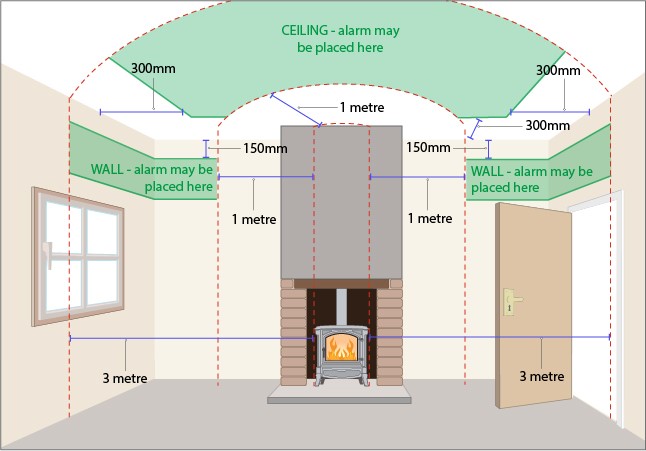Where to Place Carbon Monoxide Detector
In this article learn about the dangers of carbon monoxide, where to place carbon monoxide detector and comply with building regulations along with discovering what the symptoms of carbon monoxide poisoning are and what to do if you suspect carbon monoxide poisoning.
Danger of Carbon Monoxide
Carbon monoxide is a dangerous gas that has no smell or taste and when breathed in can make you unwell and can result in death if exposed to a high level. Carbon monoxide is produced when fuels such as gas, oil, coal and wood do not burn fully.
As these are fuels burned by users of gas fires, wood burners and multi-fuel stoves, adequate precautions must be taken to avoid any possible hazard to the health of those within the property.
Fitting a Carbon Monoxide Alarm & Complying with Building Regulations
Requirement J3 of the current building regulations Approved Document J, states that
“Where a fixed combustion appliance is provided, appropriate provision shall be made to detect and give warning of the release of carbon monoxide.”
Therefore to comply with the current building regulations, any new or replacement installation of an appliance (a gas fire, wood burner or stove) will require a carbon monoxide alarm to be fitted.
Section 2.35 of building regulations document J states
“Carbon monoxide alarms should comply with BS EN 50291:2001 and be powered by a battery designed to operate for the working life of the alarm. The alarm should incorporate a warning device to alert users when the working life of the alarm is due to pass. Mains-powered BS EN 50291 Type A carbon monoxide alarms with fixed wiring (not plug-in types) may be used as alternative applications provided they are fitted with a sensor failure warning device.”
The carbon monoxide alarm should be battery-powered and designed to operate for the life of the carbon monoxide alarm, following which it should be replaced. Alternatively a mains powered carbon monoxide alarm can be used, however this must be fitted with a sensor failure warning device.
Please note, pressing the button does not test an alarm, it merely tests the circuitry. The alarm should be tested in accordance with manufacturers instructions. CO testing kits are available and these ensure the CO alarm is detecting CO.
Section 2.36 of building regulations document J states
“The carbon monoxide alarm should be located in the same room as the appliance:
- on the ceiling at least 300mm from any wall or, if it is located on a wall, as high up as possible (above any doors and windows) but not within 150mm of the ceiling; and
- between 1m and 3m horizontally from the appliance.”
The carbon monoxide alarm must be fitted and fixed in place within the same room as the appliance and can be placed either on the ceiling or wall between 1m and 3m horizontally from the appliance. If fitting to the ceiling it must be at least 300mm from any wall, or if fitting to a wall, it must be placed as high as possible above any doors or windows at 150mm below the ceiling.
For reference, please see the below image regarding where to place carbon monoxide detector, provided by HETAS.

Carbon Monoxide Poisoning
Symptoms of carbon monoxide poisoning include; a tension-type headache, dizziness, nausea/vomiting, tiredness, confusion, stomach pain and difficulty breathing. Low short-term exposure can result in symptoms similar to flu, with longer-term exposure having a neurological impact.
Should you ever experience any of the above symptoms as a result of using your stove, we would recommend to:
- Discontinue use of the appliance
- Open all windows and doors within the property
- Leave the premises
- Contact a qualified company such as Billing Chimneys to investigate further and identity/resolve any issues with your appliance and/or flue
Further information on carbon monoxide poisoning can be found in our article Carbon Monoxide Poisoning.
Should you have any questions or queries regarding the above or would like to discuss any chimney services required, please call on 01425 475774 or email at [email protected] and we would be happy to assist you.


